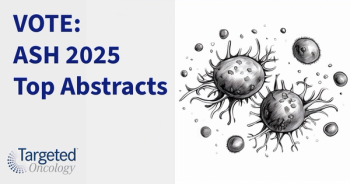
Encouraging Results Seen with Selinexor and D-Vd in Relapsed/Refractory Multiple Myeloma
Patients with late- and early-relapsed multiple myeloma receiving the combination of selinexor plus daratumumab, bortezomib, and dexamethasone showed promising efficacy and a manageable safety profile.
Patients with late- and early-relapsed multiple myeloma receiving the combination of selinexor (Xpovio) plus daratumumab (Darzalex), bortezomib (Velcade), and dexamethasone (D-Vd) showed promising efficacy and a manageable safety profile.1
Findings from the phase 2, open label, multicenter study (GEM-SELIBORDARA trial) (NCT03589222) were presented at the 63rd ASH Annual Meeting and Exposition.
“Treatment of multiple myeloma has significantly evolved in the last decade leading to significant improvements in survival,” said lead investigator Paula Rodriguez-Otero, MD, a specialist in hematology and hemotherapy and coordinator of the Central Unit for Clinical Trials at the University of Navarra, during a presentation of the findings.
“Still, cure remains elusive and new combinations incorporating drugs with novel mechanism of action are needed to rescue patients becoming resistant to standard of care,” she added.
D-Vd is a combination approved in relapsed-refractory multiple myeloma (RRMM) after 1-3 prior lines of therapy. Selinexor, which is an exportin-1 (XPO1) inhibitor, is also approved in combination with dexamethasone for the treatment of penta-exposed RRMM after 1-3 prior lines.
To analyze the effects of D-Vd and selinexor as a combination, investigators treated 57 patients from July 2018 to March 2021. The study was split into 2 parts. Part 1 examined 24 patients with 3 or more prior lines, previously treated with proteasome inhibitor (PI) and immunomodulatory drugs, and refractory to the last line or double refractory. Part 2 looked at 33 patients with RRMM who had 1 or more prior lines.
Patients were given 16mg/kg of intravenous daratumumab at the approved schedule, plus 1.3 mg/m2 bortezomib (on days 1, 8, 15, and 22 in cycle C, 1-8 and days 1 and 15 from C9 onwards), and 40mg dexamethasone (days 1, 8, 15, 22), in combination with selinexor (days 1, 8, 15, and 33). Patients in part 1 were given 100 mg of selinexor while patients in part 2 received 60 mg.
The treatment cycles last 4 weeks in part 1 and 5 weeks in part 2. Investigators continued treatment until a patient had disease progression or experienced unacceptable toxicity. They followed the Declaration of Helsinki and ICHGCP guidelines.
In part 1, in which patients had a median age of 65.5 years and a median of 3 prior lines, 96% (MM refractory to last line) and 71% (double refractory) of patients had MM refractory to lenalidomide and PI. Among them, 21% of patients had high-risk cytogenetics (HR-CA), and 12.5% had R-ISS 3.
The overall response rate (ORR) in part 1 was 50%. A total of 3 patients (12%) achieved complete response/stringent complete response (CR/sCR). At a median follow-up of 28.3 months, 18 patients had discontinued treatment (14 due to disease progression). The median progression-free survival (PFS) and overall survival (OS) were 7.1 (95% CI 3.4 – 20.0) and 27.5 months (95% CI 10.6 – NE), respectively.
Part 2 had a median age of 69 years and a median of 1 prior line of therapy(61% had 1) . Similar to part 1, 45% of patients were refractory to lenalidomide — 12% were double refractory and 36% were refractory to last line. There were 5 patients with HR-CA and 3 with R-ISS 3.
At a median follow-up of 9.8 months, 8 patients in part 2 had discontinued treatment (5 due to disease progression). There was an ORR of 82%, and 8 patients (24%) achieved CR/sCR. Median PFS was not yet reached (95% CI 12.1 – NE), while median PFS in lenalidomide-refractory patients included in this part (n=15) was 12.1 months. Median OS was also not yet reached (95% CI NE-NE).
Adverse events (AEs) were manageable. Investigators recommended supportive care to prevent nausea associated with selinexor (with or without anorexia), including ondansetron for 2 days and olanzapine daily.
Seventy-seven percent of patients experienced hematological AEs, including: thrombocytopenia (8.4%; grade 3-4 in 34%), and neutropenia (33%; grade 3-4 in 25%).
Non-hematological AEs were reported in 75% of patients: gastrointestinal toxicity (38%), nausea (28%, 2 grade 3-4), diarrhea (21%; 1 grade 3-4), asthenia (35%; 6 grade 3-4), and peripheral neuropathy (12.3%; 0 grade 3-4).
Dose modifications were required in 35 patients (61.4%), with selinexor being the most likely to be modified (15 in part 1 and 14 in part 2). It was discontinued in 5 patients. Only 1 patient discontinued the study due to AEs. In part 1, 2 patients died.
“All the data in this second cohort is still immature and requires a longer follow-up,” Rodriguez-Otero concluded.
Reference:
1. Rodriguez-Otero P, González-Calle V, Sureda A, et al. Selinexor in Combination with Daratumumab-Bortezomib and Dexamethasone for the Treatment of Relapse or Refractory Multiple Myeloma: Initial Results of the Phase 2, Open-Label, Multicenter GEM-Selibordara Study. Presented at: 63rd ASH Annual Meeting and Exposition; December 11-14, 2021. Atlanta, GA. Abstract 1677.









































